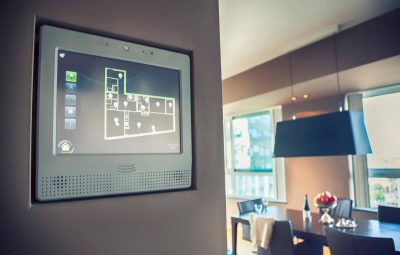When you choose energy-efficient lighting for your home, you will have to choose bulbs and fixtures that are specifically designed to require less energy, all while providing an adequate amount of light needed.
Great choices with Big Easy Electricians can lessen energy bills and help make the planet a little bit greener. Call us to start your project to a brighter and greener home.

If you are choosing energy-efficient lighting for your home, you want to balance equal parts function, cost, and energy savings. Check out these tips to help you make your decision.
Before you begin to illuminate your rooms, know how you will illuminate your rooms. With task lighting, such as under-cabinet kitchen lighting, the light should be at a brighter level to push the light into a little spot. Ambient lights, such as the lamps you use for your living room, are softer and not as bright.
Lumens measure brightness and do not measure how much energy is used. Look for these bulbs that have 800-1000 lumens or more for brightness in kitchens or offices. The bedroom lighting is dimmer and would require approximately 400-700.
Energy Star- labelled bulbs go through strict guidelines for efficacy. Look carefully, check wattage, and pair lumens so you can know the bulb matches your intention. LEDs will last 25 times longer than incandescent bulbs usually.
Always check that the bulb you are using is by the fixture and dimmer. This will generally prevent programming issues and loss of energy savings.
Color temperature describes light appearance. Warm white (2700K-3000K) gives off a warm environment and is appropriate for bedrooms and living rooms. Cool white (3500K-4100K) gives off clarity and is appropriate for kitchens and bathrooms. Daylight (5000K-6500K) gives off a bright, cooler, more vibrant light and is appropriate in active spaces such as home offices.
All temperatures should be paired with the “mood and functions” of each room.
The fixture has to support the bulb type you want to use. Generally speaking, LED-ready fixtures will give you the best results overall. Layout is also important. Wall sconces, pendants, or recessed lights that are intended to create beams of light illuminate a spot and reflect the entire space’s aesthetic. Consider smart or dimming fixtures that allow you to adjust the lighting if necessary.

The light design improvements in technology have not only made the light design more energy efficient, but they have also opened doors of opportunity for homeowners, offering functional solutions! Picking the best light involves knowing what the important technologies are, what they do, and what works in your home!
LED bulbs are among the most efficient and longest-lasting lights you can buy. They are great for ambient and task lighting, evenly illuminating areas. LEDs are extremely customizable, offered in all sorts of color temperatures to suit the ambiance of any environment, from warm white and soft for living rooms, or cooler shades for office spaces.
CFLs are an affordable step above incandescents, consuming approximately 70% less energy. They’re ideal for spaces where the lights are on for prolonged periods– for example, kitchens or family rooms. They also only offer a small energy savings and provide ambient light, and are a safe go-to for any penny-pinching homeowner.
Learn to see the give or take between brightness, color, and quality so you are able to make appropriate choices and make your home light beautifully, with the most energy-efficient means you can.
Select lumens, not watts. Wattage only documents energy consumed, while lumens document the visible light emitted. Wasting energy due to over-lighting costs you money, but under-lighting can strain your eyes. Go for dimmable LED bulbs — particularly in rooms that serve multiple functions.
Light color is measured in kelvin (K), which changes from warm (2700K) to cool (5000+ K). Warm colors create a feeling of comfort and homey warmth, which may be considered for living rooms or bedrooms. Neutral colors (3000K – 4000K) may be suitable for environments requiring increased attention, such as kitchens and offices.
High-grade bulbs last longer, don’t dim, and don’t flicker, which is stressful on your eyes and gives you headaches. Good brands should ship bulbs with a CRI over 80, which, for many, is an important consideration because the colors really pop. LEDs barely get hot, so the fire danger is nearly eliminated, and energy efficiency is increased. Choosing hardy bulbs and replacements will result in lower costs, and reliability will be higher.
Choosing energy-efficient light is a way to lower your energy bills and improve the comfort level of your home. Energy-efficient lights waste less energy and last longer. They also create a brighter, more inviting atmosphere while helping reduce your environmental footprint. Making the switch may seem small, but it’s a choice that benefits both your home and the planet.
For safe and reliable installation, partner with us at Big Easy Electricians. Let’s make your home brighter, more efficient, and worry-free. Contact us today, and we’ll help you get started.
Have you ever wondered how to safeguard your home during a lightning storm? Lightning strikes unexpectedly and can cause serious damage. Surge protectors and lightning rods are essential tools to p...
Read MoreTable of Contents Key Takeaways Understanding Electrical Hazards Recognize Common Electrical Hazards Risks of Aging or Faulty Wiring How to Improve Electrical Safety at Home R...
Read MoreThese solutions effectively light indoor spaces, whether in homes or businesses, and provide safety during bad weather or power outages. For instance, we incorporate weatherproof fixtures, bury wir...
Read MoreVarious causes of fires include poor wiring, overloaded circuits, and antiquated electrical panels. Other fire dangers include snake-like connections with circuit breakers, and surge protectors wit...
Read MorePower surges occur when there is an untimely boost of electrical current, typically brought about by lightning strikes, faults in utility grids, or the turning on and off of huge appliances. Power ...
Read MoreFor safe and efficient electrical systems, current codes of safety and rules of compliance need to be understood. Codes comply with the National Electrical Code (NEC) and stipulate installation, ma...
Read More